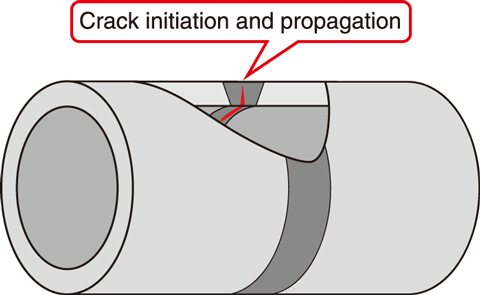
Fig.2-17 Image of a crack in a pipe

Fig.2-18 Evaluation examples of influence of ISI on failure probability
Cracks can initiate and propagate in the welds of pipes due to aging degradation during long-term operation of nuclear power plants (Fig.2-17). These cracks may cause pipe failure. To ensure the structural integrity of pipes, non-destructive examinations are performed for welds as a part of in-service inspection (ISI). In case of a crack detection, structural integrity assessment, including crack growth and pipe failure evaluations, is performed. If the structural integrity of the cracked pipe cannot be ensured, the pipe is repaired or replaced. Therefore, ISI has an important role in ensuring the structural integrity of pipes.
In some countries, such as the United States, a risk informed ISI (RI-ISI) is applied to focus inspection resources on important pipes for plant safety, in which the failure probability of the piping system including multiple welds is calculated as a numerical index. The ratio of welds to be inspected in piping system is then determined based on the calculated failure probability. Probabilistic fracture mechanics (PFM) is considered as an evaluation method applicable to RI-ISI. In this method, crack existence or initiation in a weld is considered and crack growth and pipe failure evaluation are performed considering the uncertainties of influential factors. A huge number of pipe evaluations are computed based on the Monte Carlo method for evaluating failure probability, which is the ratio of the number of failed pipes to the total number of evaluated pipes. In addition, PFM can simulate crack detection through the probability of crack detection (POD) model as well as repair or replacement of pipes in ISI. Thus, failure probability can be calculated reasonably and quantitatively by using PFM.
We have been developing a PFM analysis code PASCAL-SP, for piping system. This work has aimed to evaluate the influence of the ratio of welds to be inspected on failure probability of a piping system using PASCAL-SP.
The failure probability of a weld in typical carbon steel piping system was first evaluated; results are shown in Fig.2-18(a). The cumulative failure probability was shown to increase with operation time due to fatigue crack propagation; the increasing failure probability was mitigated by ISI. Then, a failure probability calculation method was developed for the piping system including multiple welds and used to evaluate the influence of the ratio of welds to be inspected. Here, two POD models of “Very high” and “Normal” which express different accuracy of ISI proposed in the United States were used. The evaluation results are shown in Fig.2-18(b). The failure probability decreased with the increase of the ratio of welds to be inspected. In addition, when ISI with “Very high” accuracy was implemented, even with 10% low ratio of welds to be inspected, it can have the same failure probability in the case of “Normal” accuracy in ISI.
Overall, the application of the PFM evaluation method allows for more reasonable determination of the ratio of welds to be inspected. Future work will continue the research for practical use of PFM including RI-ISI.
This study was partly supported by the Secretariat of the Nuclear Regulation Authority (NRA), Japan.